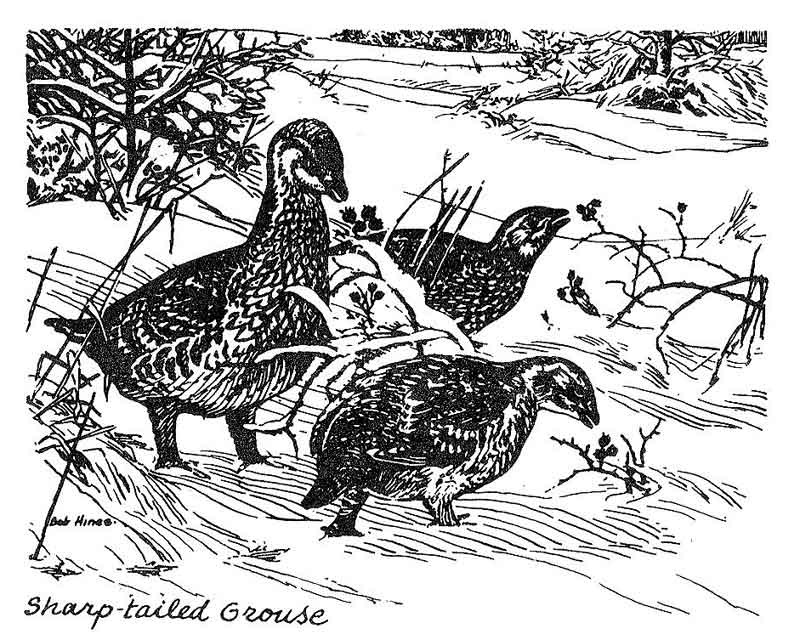|
| 질의: Great white | 결과: 342번째/746 | |
Sharp-tailed Grouse (Tympanuchus phasianellus) - Wiki
| 제목: | Sharp-tailed Grouse (Tympanuchus phasianellus) - Wiki
| |

| 해상도: 800x640
파일크기: 99721 Bytes
등록시간: 2007:10:26 13:48:58
|
Sharp-tailed Grouse
From Wikipedia, the free encyclopedia
[Photo] Sharp-tailed Grouse (Tympanuchus phasianellus) painting. Source: USFWS.
The Sharp-tailed Grouse, Tympanuchus phasianellus, is a medium-sized prairie grouse. Males weigh an average of 33.5 oz. (951 g) and females average 29 oz. (815 g). The Greater Prairie-Chicken, Lesser Prairie-Chicken, and Sharp-tailed Grouse make up the genus Tympanuchus, a genus of grouse found only in North America.
There are six subspecies:
T. p. phasianellus: the nominate race or Northern sharp-tailed grouse is found in Manitoba, northern Ontario, and central Quebec. Partially migratory.
T. p. kennicotti: the Northwestern sharp-tailed grouse, resident from the Mackenzie River to Great Slave Lake in the Northwest Territories, Canada.
T. p. caurus: the Alaska sharp-tailed grouse, north-central Alaska east to the southern Yukon, northern British Columbia, and northern Alberta.
T. p. columbianus: the Columbian sharp-tailed grouse can be found in isolated pockets of native sagebrush and bunchgrass plains of Idaho, Wyoming, Colorado, Utah, and British Columbia.
T. p. campestris: the Prairie sharp-tailed grouse, lives in southeastern Manitoba, southwestern Ontario, and the Upper Peninsula of Michigan to northern Minnesota and northern Wisconsin. This subspecies coexists with the Plains race around the northern Red River valley and prefers low seral stages of recently converted forests to shrubland.
T. p. jamesi: the Plains sharp-tailed grouse makes its home in the northern Great Plains in southern Alberta and Saskatchewan, eastern Montana, North and South Dakota, Nebraska, and northeastern Wyoming. This race lives in the mixed grass prairie preferring a mosaic of native grasslands, cropland, and brushy/woody riparian draws, creeks, and rivers for a winter food source above the snow cover as buds and berries.
Adults have a relatively short tail with the two central (deck) feathers being square-tipped and somewhat longer than their lighter, outer tail feathers giving the bird its distinctive name. The plumage is mottled dark and light browns against a white background, they are lighter on the underparts with a white belly uniformly covered in faint "V"-shaped markings. Adult males have a yellow comb over their eyes and a violet display patch on their neck. The female is smaller than the male and can be distinguished by the regular horizontal markings across the deck feathers as opposed to the irregular markings on the males deck feathers which run parallel to the feather shaft. Females also tend to have less obvious combs.
These birds forage on the ground in summer, in trees in winter. They eat seeds, buds, berries, forbs, and leaves, also insects, especially grasshoppers, in summer.
These birds display in open areas known as leks with other males, anywhere from a single male to upwards of 20 will occupy one lek (averaging 8-12). Males stamp their feet rapidly, about 20 times per second, and rattle their tail feathers while turning in circles or dancing forward. Purple neck sacs are inflated and deflated during display. The females select the most dominant one or two males in the center of the lek, copulate, and then leave to nest and raise the young in solitary from the male. Occasionally a low-rank male may disguise himself as a female and walk to where the dominant male is and fight him.
These birds are declining in numbers and range due to habitat loss.
This is the provincial bird of Saskatchewan.
http://en.wikipedia.org/wiki/Sharp-tailed_Grouse
| The text in this page is based on the copyrighted Wikipedia article shown in above URL. It is used under the GNU Free Documentation License. You may redistribute it, verbatim or modified, providing that you comply with the terms of the GFDL. |
|
^o^
동물그림창고 똑똑전화 누리집
^o^
|
|